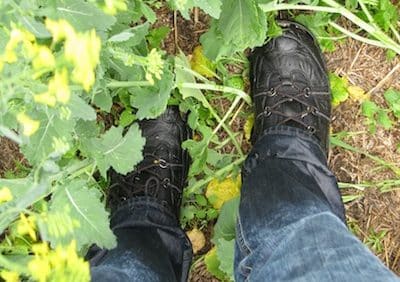Sclerotinia stem rot will likely occur if a field has regular rains or high humidity or both from two to three weeks before flowering and through flowering. This will get spore-releasing apothecia going in time to be active during flowering, dispersing spores on petals (and everywhere else in the canopy). If moist conditions continue after flowering, severity of the disease could be high and yield loss significant.
With these conditions and yield potential of 30 bu./ac. or greater, a fungicide application at 20-30% flower is warranted.
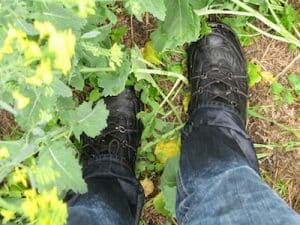
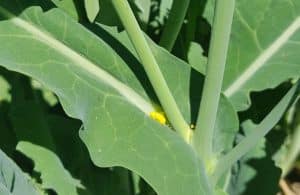
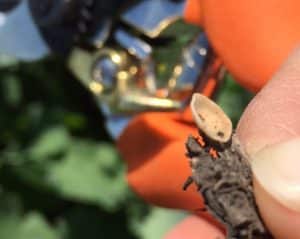
But the decision to spray is rarely so clear. The following situations can make the spray decision more difficult and confusing:
Hot weather. Hot, dry weather should reduce the risk of heavy sclerotinia infection, even if moist weather earlier promoted a lot of apothecia emergence and spore release. Keep in mind that “moisture” to promote sclerotinia does not have to be rainfall. Hot, humid weather that leads to morning dew and a humid canopy can promote the disease. Even if days get hot, if moisture and humidity are abundant through the canola canopy, it may be worthwhile spraying. Keep in mind that even thought the sclerotinia fungus does not like to grow over temperatures of 30°C, night temperatures are often lower and will allow for fungal growth.
On the other hand, hot weather during flowering can increase flower and pod abortion and reduce overall yield potential. Hot, dry weather during pod fill and ripening also reduces the progression of sclerotinia within the plant.
Return on investment from a fungicide applications is more likely if yield potential is 30-35 bu./ac. — or more. Crop canopy for a higher-yielding crop will also restrict air movement and retain moisture, resulting in a humid canopy that promotes infection.
Fungicide performance factors. Hot conditions can increase evaporation of the spray, reducing its performance. Some companies say to avoid spraying in temperatures above 25-27°C. A tip is to keep the water volumes at a minimum of 10 gallons per acre and the spray droplet quality at least in the coarse range. This will help to reduce rapid droplet evaporation while still maintaining very good target coverage. Rainfastness varies by product. Some can be applied as little as 30 minutes before a rain. Others are recommended to have at least 3 hours before a rain. Also use the appropriate nozzle filter screens to improve fungicide performance. Bayer recommends 50 mesh for Proline as finer screens may cause plugging issues.
Variable stages within crops. Variable stages mean a longer flowering period across the field and an increased challenge to time the fungicide application. Are plants at later stages healthier and more plentiful? If yes, timing an application to protect those plants might be the better move. If difficult to tell which stages will contribute most to yield, a split application may be preferred.
Lower plant populations. Fewer plants mean more side branches. This extends the flowering window and could mean that 50% flower stage, the end point for fungicide application, could be delayed. This creates scenarios that support a split application, or where return on investment can be significantly different for early-window versus late-window applications if the moisture situations changes significantly through the flowering stage and sclerotinia infection cycle.
Late-window sprays. The application window for most fungicides closes at 50% flower. (See the table at the bottom.) If conditions were hot and dry before flowering, then turn moist during flowering, the economic return from fungicide could be higher with a late-window application. This would be especially true if moisture also promoted a longer flowering window due to later compensatory growth. With lower seeding rates resulting in more branching, canola fields can be at 50% flower for a week or more. Keep in mind however that infection to side branches tends to have a lower overall effect on yield than infection on main stems, and that late applications for some products may be getting close to their pre-harvest intervals.
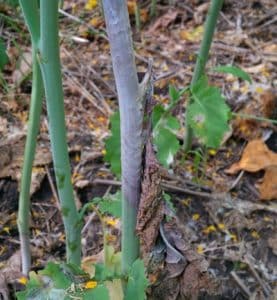
A scenario…
A reader came to us with this question: We have had less than an inch of rain the last 2 weeks and about 7/10 just prior to that. I did notice some moisture deep in the canopy, but the weather forecast is for above 30 degrees for the next few days. The canola is at 20 plus percent flowering and there is a field history of sclerotinia. Does the grower spray for disease? Also, why does the fungicide window close at 50% flower?
Answer: This is one of those situations that make the sclerotinia spray decision so difficult. Canopy moisture and humidity are key and it may not take much rain to cause infection. While this farm has been fairly dry over the past two weeks, if moisture was moderate to ample leading up to canopy cover, the situation for spore release will be there. If pants get wet from dew while walking through the canopy each morning, this indicates a moist canopy environment. However, if the field did not reach moisture capacity at any point during the season, apothecia may not have germinated. This is a case where a petal test to identify the presence of spores may help with the decision.
Field history is a factor. Given the field history of sclerotinia, the inclination would be to spray unless weather conditions and yield outlook change the situation.
Yield outlook is also important. Sclerotinia fungicide is more likely to provide a return on investment if canola yield is 30 bu./ac. or more. Hot, dry weather during flowering will reduce pod-set and if these conditions persist during pod fill and ripening, it will also reduce the progression of sclerotinia within the plant.
Watch the weather forecast. In 2016, with repeated showers and extended flowering, some growers found that a second application was needed and sometimes provided better control than the first application of fungicide. Or if conditions pre-flower were too dry for disease but changed in flower, a late window application may pay off – especially if moisture greatly extends the full-flower period.
As for the window: Petal drop begins at 30% flower and petal production peaks at 50% flower. The window closes at 50% because (1) fungicide targets petals (which later drop and break down, feeding the spores and allowing disease penetration into stems), (2) early infection tends to cause the highest yield loss, and (3) pre-harvest intervals become a factor with late applications.
Further reading:
Sclerotinia stem rot: Risk factors and spray timing
Sclerotinia risk assessment tool
How to count 10-15% flower
Canola Encyclopedia: Sclerotinia stem rot
NDSU presentation on sclerotinia and weather effects
[supsystic-tables id=’2′]

